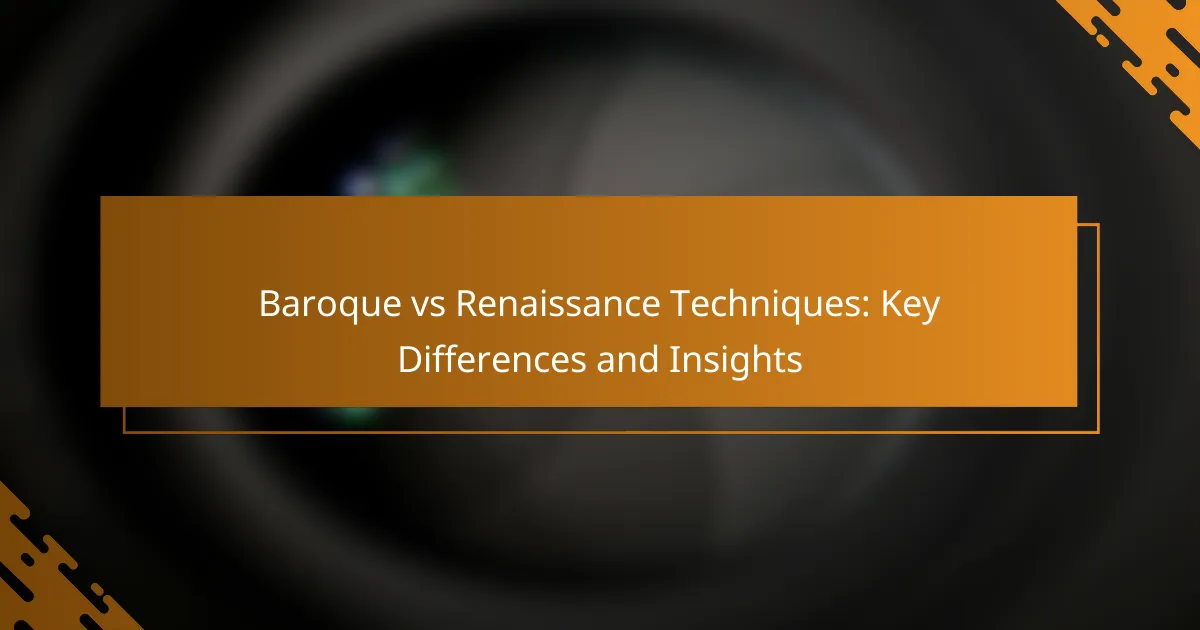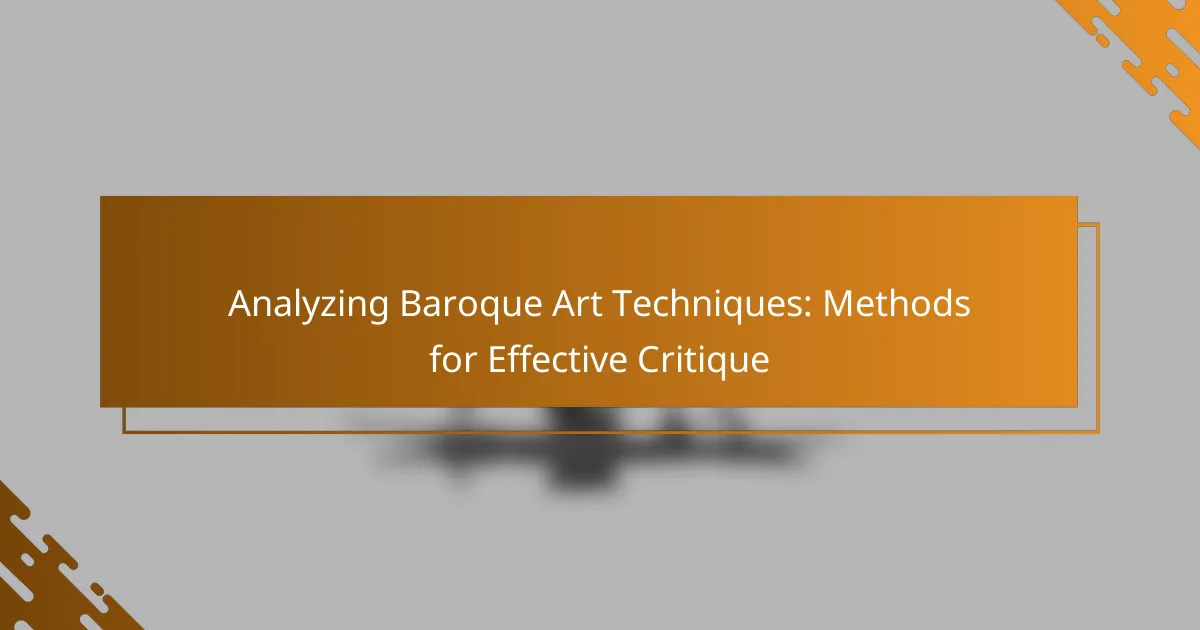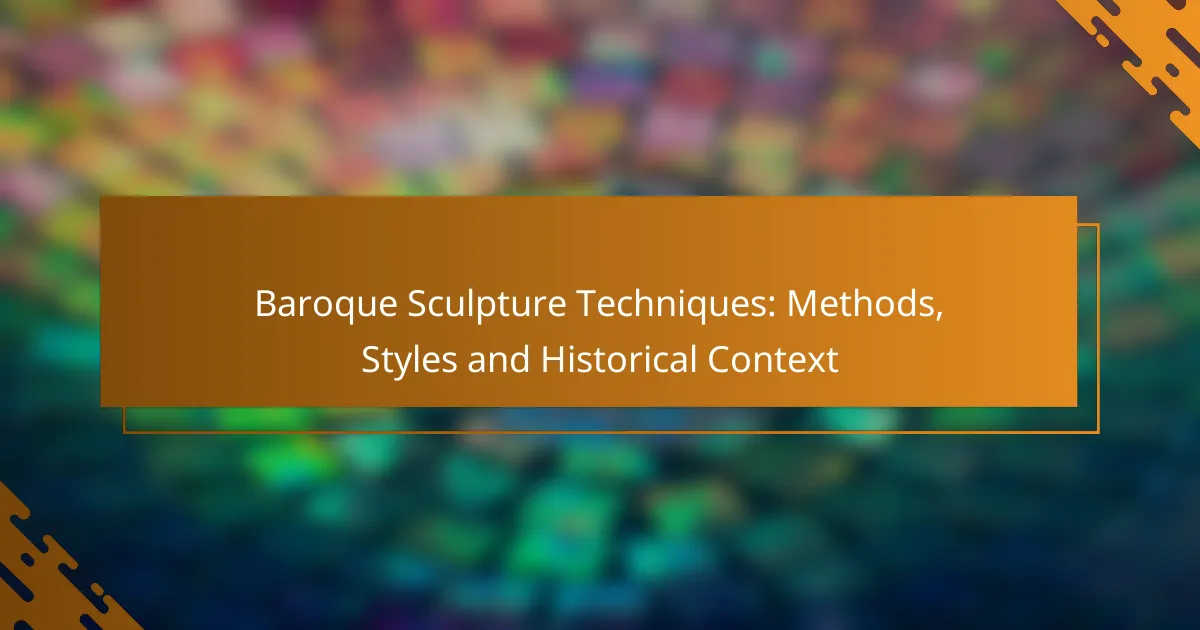The Baroque and Renaissance periods represent two distinct approaches to art, each with unique techniques and emotional expressions. While Renaissance art focuses on balance and harmony, Baroque art is marked by dramatic intensity and movement, showcasing a shift towards emotional engagement. Understanding these differences not only highlights the evolution of artistic styles but also informs contemporary practices in the art world.
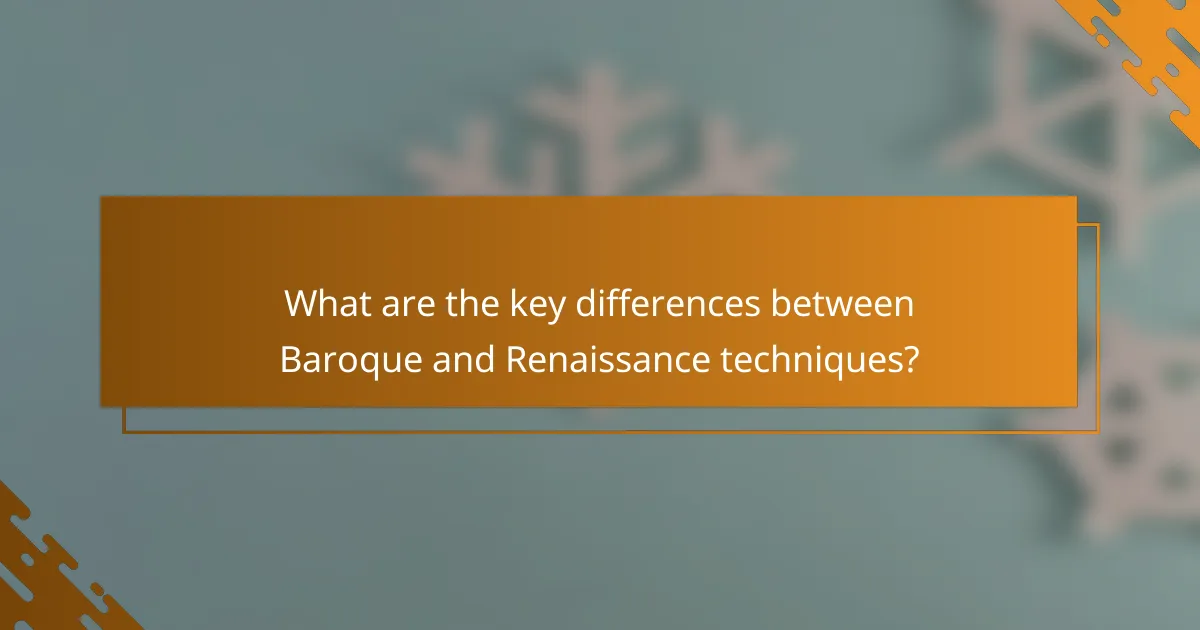
What are the key differences between Baroque and Renaissance techniques?
The key differences between Baroque and Renaissance techniques lie in their emotional expression, use of color, and compositional styles. Baroque art is characterized by dramatic intensity and movement, while Renaissance art emphasizes balance, harmony, and proportion.
Baroque emphasizes emotion and drama
Baroque techniques are designed to evoke strong emotions and create a sense of drama. Artists often used dynamic poses, intense facial expressions, and theatrical lighting to draw viewers into the scene. This approach aimed to engage the audience on a personal level, making the artwork feel alive.
For example, in paintings like Caravaggio’s “The Calling of Saint Matthew,” the use of chiaroscuro enhances the emotional impact, highlighting the moment of divine intervention. Such techniques were intended to inspire awe and reflection among viewers.
Renaissance focuses on harmony and proportion
In contrast, Renaissance techniques prioritize harmony and proportion, reflecting a deep interest in classical ideals. Artists aimed for balanced compositions that conveyed a sense of order and clarity. This focus on proportion is evident in works like Leonardo da Vinci’s “Vitruvian Man,” which exemplifies the mathematical ratios of the human body.
Renaissance artists often employed linear perspective to create depth, allowing viewers to experience a three-dimensional space on a two-dimensional surface. This technique helped establish a sense of realism and coherence in their works.
Baroque uses bold colors and contrasts
Baroque art is known for its bold colors and stark contrasts, which contribute to its dramatic effect. Artists frequently used rich, vibrant hues to create a sense of movement and energy. The interplay of light and shadow, or chiaroscuro, was a hallmark of this style, enhancing the emotional intensity of the artwork.
For instance, in paintings by artists like Peter Paul Rubens, the use of vivid colors and dramatic contrasts draws the viewer’s eye and heightens the sense of action within the scene. This technique was effective in capturing attention and conveying powerful narratives.
Renaissance employs softer palettes and balanced compositions
Renaissance techniques typically feature softer color palettes and balanced compositions, promoting a sense of tranquility and order. Artists often used muted tones and subtle gradations to create a harmonious visual experience. This approach allowed for a more serene interpretation of subjects, focusing on beauty and grace.
In works like Raphael’s “The School of Athens,” the use of soft colors and symmetrical arrangements reflects the ideals of balance and intellectual harmony. Such techniques invite contemplation and appreciation of the beauty in simplicity and proportion.
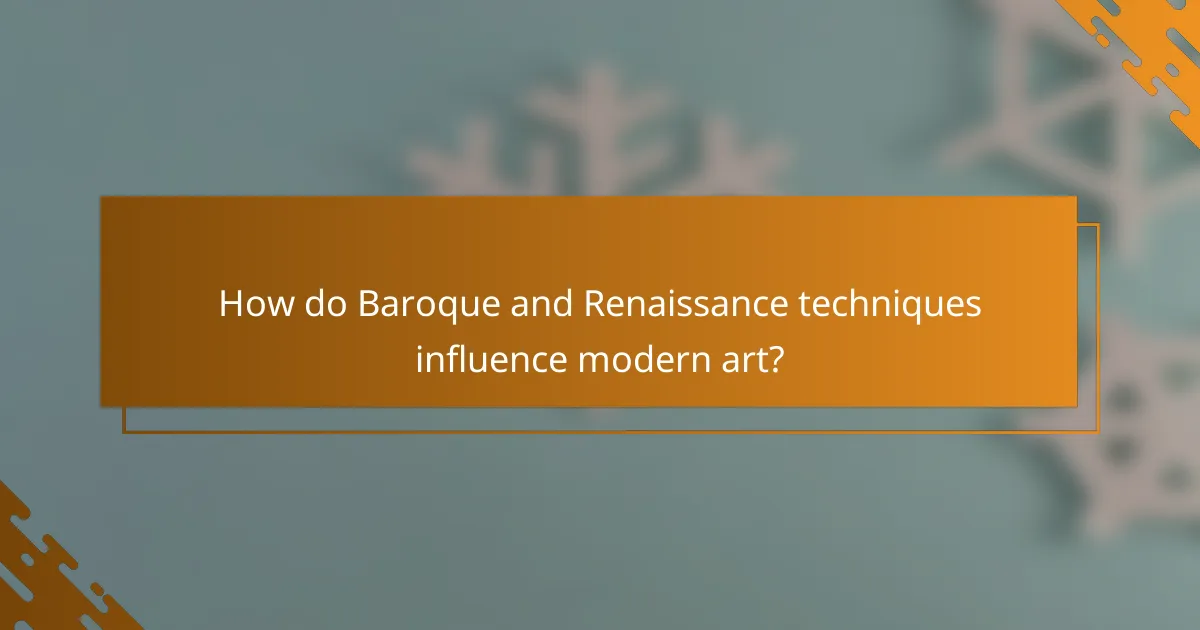
How do Baroque and Renaissance techniques influence modern art?
Baroque and Renaissance techniques significantly shape modern art by emphasizing emotion, drama, and clarity in design. These historical styles inform contemporary practices in various artistic fields, enhancing the way artists express ideas and engage audiences.
Baroque inspires theatricality in contemporary performances
Baroque art is characterized by its dramatic use of light, shadow, and movement, which has influenced modern theatrical performances. Contemporary theater often employs similar techniques to create immersive experiences, utilizing dynamic lighting and elaborate staging to evoke strong emotional responses.
For instance, modern productions may incorporate Baroque-inspired elements such as grandiose set designs and intense character portrayals. This approach helps to captivate audiences, drawing them into the narrative with heightened sensory engagement.
Renaissance principles guide modern design and architecture
The Renaissance period introduced principles of symmetry, proportion, and perspective that continue to guide modern design and architecture. These foundational concepts are essential in creating visually appealing and functional spaces, ensuring that structures resonate with harmony and balance.
Architects today often reference Renaissance ideals when planning urban spaces or designing buildings, aiming for a blend of aesthetic beauty and practicality. For example, the use of open spaces and natural light in contemporary architecture reflects Renaissance influences, promoting a sense of well-being and connection to the environment.
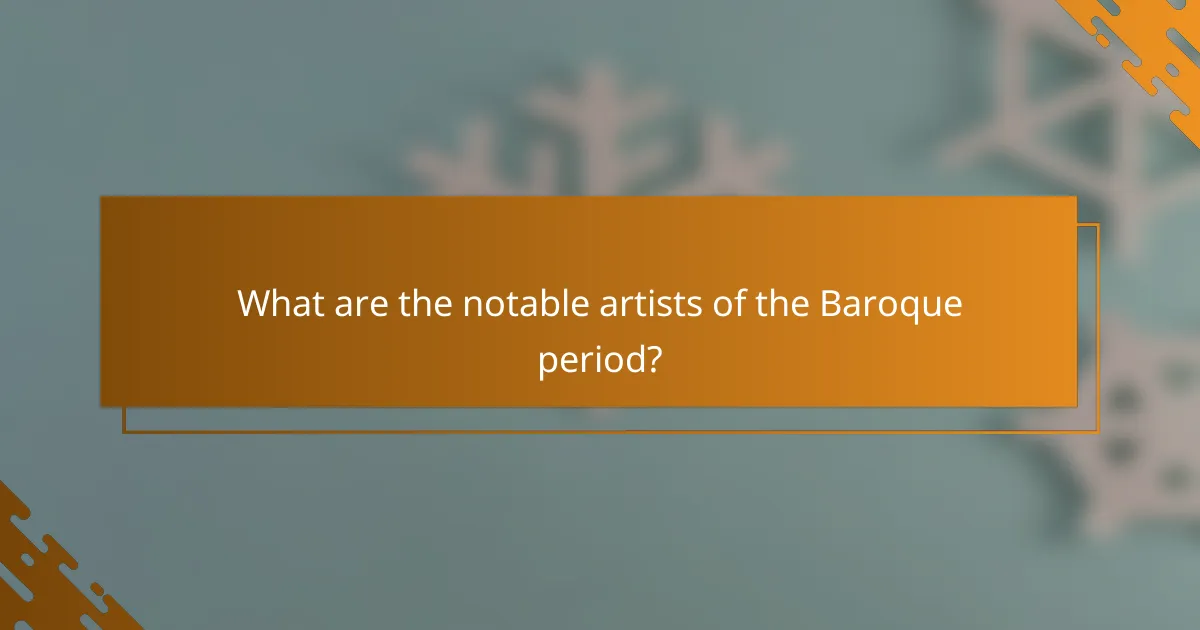
What are the notable artists of the Baroque period?
The Baroque period, spanning from the late 16th century to the early 18th century, is characterized by dramatic expression and grandeur in art. Key artists like Caravaggio and Peter Paul Rubens exemplify the distinctive techniques and themes of this era.
Caravaggio known for chiaroscuro
Caravaggio is renowned for his mastery of chiaroscuro, a technique that contrasts light and dark to create a sense of volume and depth. This method not only enhances the dramatic effect of his paintings but also draws the viewer’s attention to the focal points within the artwork.
His notable works, such as “The Calling of Saint Matthew,” showcase this technique effectively, using stark lighting to highlight figures against dark backgrounds. Artists looking to emulate Caravaggio’s style should consider using strong contrasts to evoke emotion and narrative in their pieces.
Peter Paul Rubens famous for dynamic compositions
Peter Paul Rubens is celebrated for his dynamic compositions, which often feature movement and energy. His ability to create a sense of action within a scene is evident in works like “The Descent from the Cross,” where figures appear to be in motion, engaging the viewer’s eye across the canvas.
Rubens’ use of color and form contributes to the liveliness of his paintings, making them visually striking. Aspiring artists can learn from Rubens by incorporating fluid lines and vibrant palettes to convey vitality and drama in their own compositions.
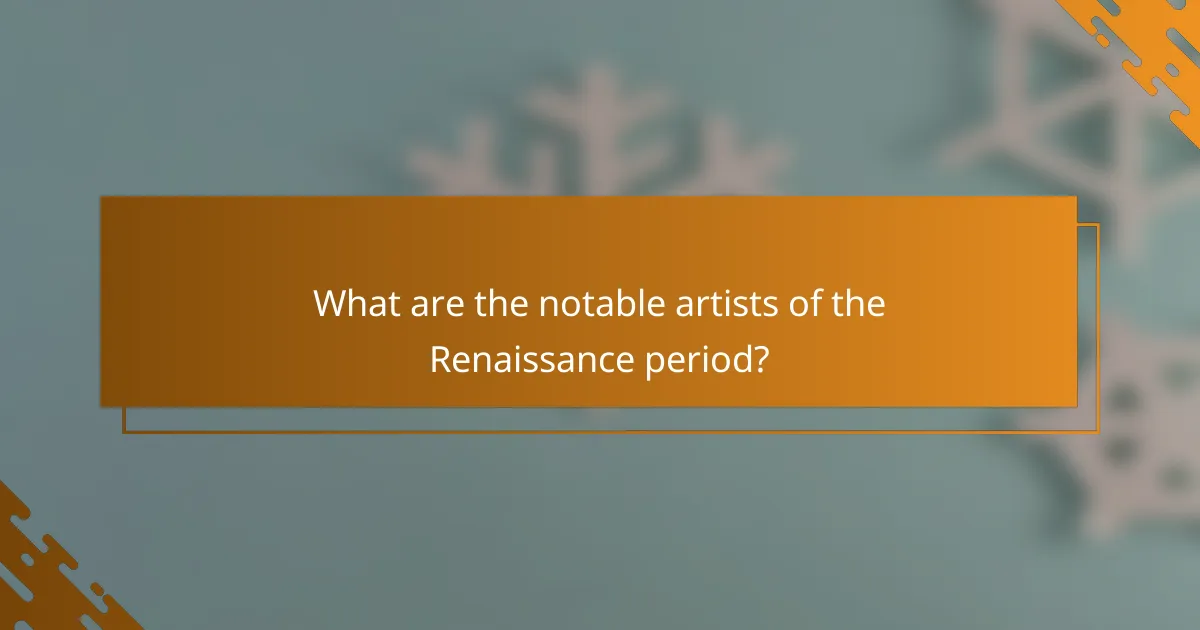
What are the notable artists of the Renaissance period?
The Renaissance period is marked by several influential artists who significantly advanced techniques in art and human representation. Key figures include Leonardo da Vinci, Michelangelo, and Raphael, each known for their unique contributions that shaped the artistic landscape of the time.
Leonardo da Vinci recognized for anatomical precision
Leonardo da Vinci is renowned for his meticulous studies of human anatomy, which greatly enhanced the realism in his artwork. His detailed sketches and paintings, such as the “Vitruvian Man,” showcase his understanding of proportion and movement, making him a pioneer in anatomical accuracy.
To achieve such precision, da Vinci often dissected cadavers, allowing him to observe muscle structure and bone alignment firsthand. This practice not only informed his art but also laid the groundwork for future anatomical studies.
Michelangelo celebrated for sculptural mastery
Michelangelo is celebrated for his exceptional skill in sculpture, particularly evident in masterpieces like “David” and the “Pietà.” His ability to convey emotion and physicality through marble set a high standard for sculptural art during the Renaissance.
Michelangelo’s techniques involved a deep understanding of human form and movement, often drawing inspiration from classical antiquity. His sculptures are characterized by their dynamic poses and intricate details, demonstrating his mastery over the medium.
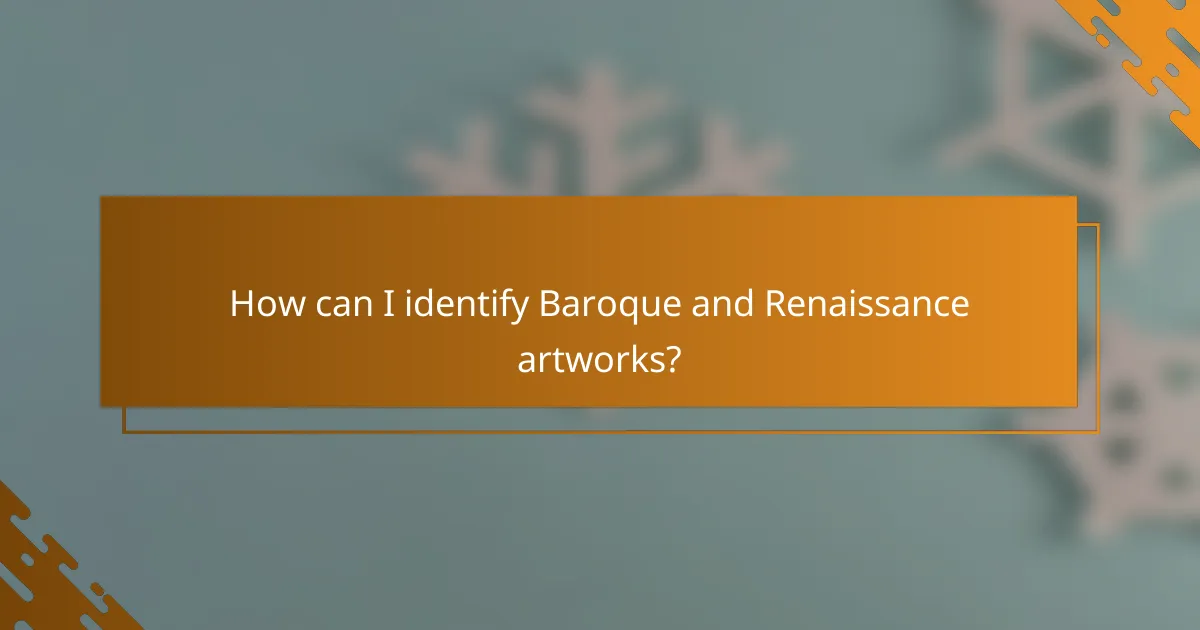
How can I identify Baroque and Renaissance artworks?
To identify Baroque and Renaissance artworks, focus on their distinct characteristics. Baroque art often emphasizes dramatic expressions and movement, while Renaissance art is marked by harmony, proportion, and clarity.
Look for emotional expressions in Baroque pieces
Baroque artworks are known for their intense emotional expressions and dynamic compositions. Artists like Caravaggio and Bernini used light and shadow to create dramatic contrasts, enhancing the emotional impact of their subjects.
When examining a Baroque piece, look for exaggerated facial expressions, dynamic poses, and a sense of movement. These elements are designed to evoke strong feelings and engage the viewer on a deeper emotional level.
Seek balanced proportions in Renaissance works
Renaissance art is characterized by balanced proportions and a focus on symmetry. Artists such as Leonardo da Vinci and Michelangelo adhered to classical ideals of beauty, emphasizing harmony and mathematical ratios in their compositions.
To identify Renaissance works, observe the use of perspective, realistic human figures, and a clear organization of space. These elements create a sense of order and tranquility, distinguishing them from the emotional intensity of Baroque art.
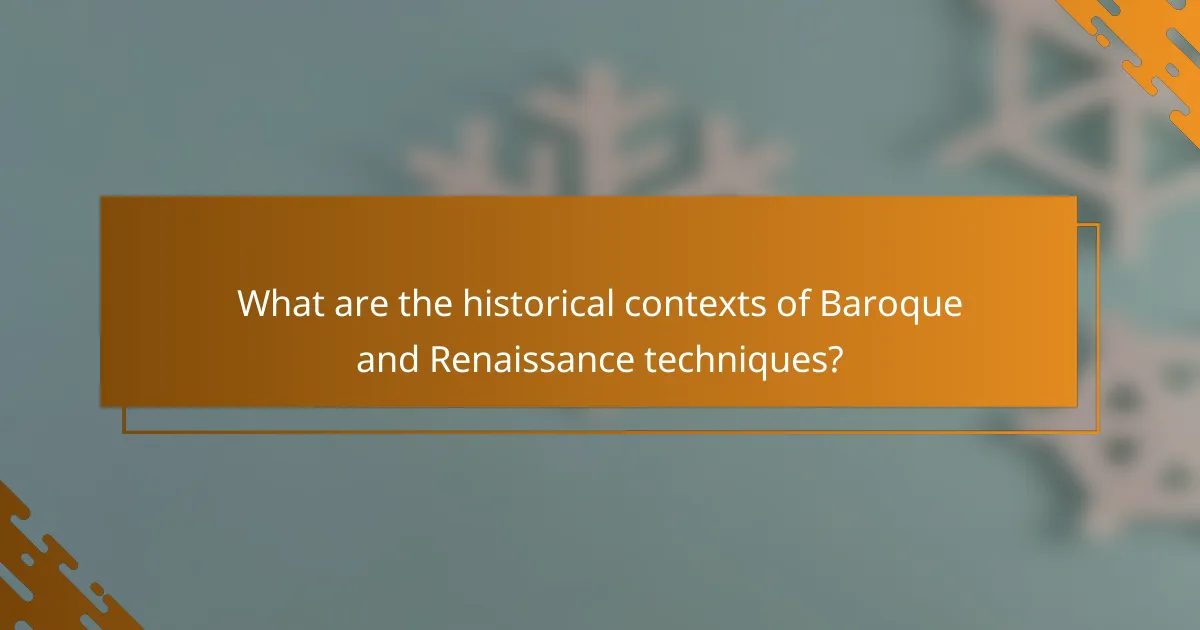
What are the historical contexts of Baroque and Renaissance techniques?
Baroque and Renaissance techniques emerged during distinct historical periods, each reflecting the cultural and religious shifts of their time. The Renaissance, spanning roughly from the 14th to the 17th century, focused on humanism and classical antiquity, while the Baroque period, from the late 16th to the early 18th century, was heavily influenced by the Counter-Reformation and aimed to evoke emotional responses through art.
Baroque reflects the Counter-Reformation influence
The Baroque style developed as a response to the Catholic Church’s efforts to regain followers during the Counter-Reformation. Artists used dramatic contrasts, intense emotions, and elaborate details to create works that inspired awe and devotion.
Key characteristics of Baroque techniques include the use of chiaroscuro (light and shadow), dynamic compositions, and grand scale. For example, Caravaggio’s paintings often feature stark lighting to highlight the emotional intensity of his subjects.
Renaissance emerges from humanism and classical revival
The Renaissance was rooted in humanism, emphasizing the value of individual experience and the study of classical texts from ancient Greece and Rome. This period marked a shift towards realism, proportion, and perspective in art and architecture.
Renaissance techniques often involved the use of linear perspective to create depth, as seen in works by artists like Leonardo da Vinci and Michelangelo. Their focus on anatomical accuracy and the beauty of the human form set a foundation for future artistic endeavors.
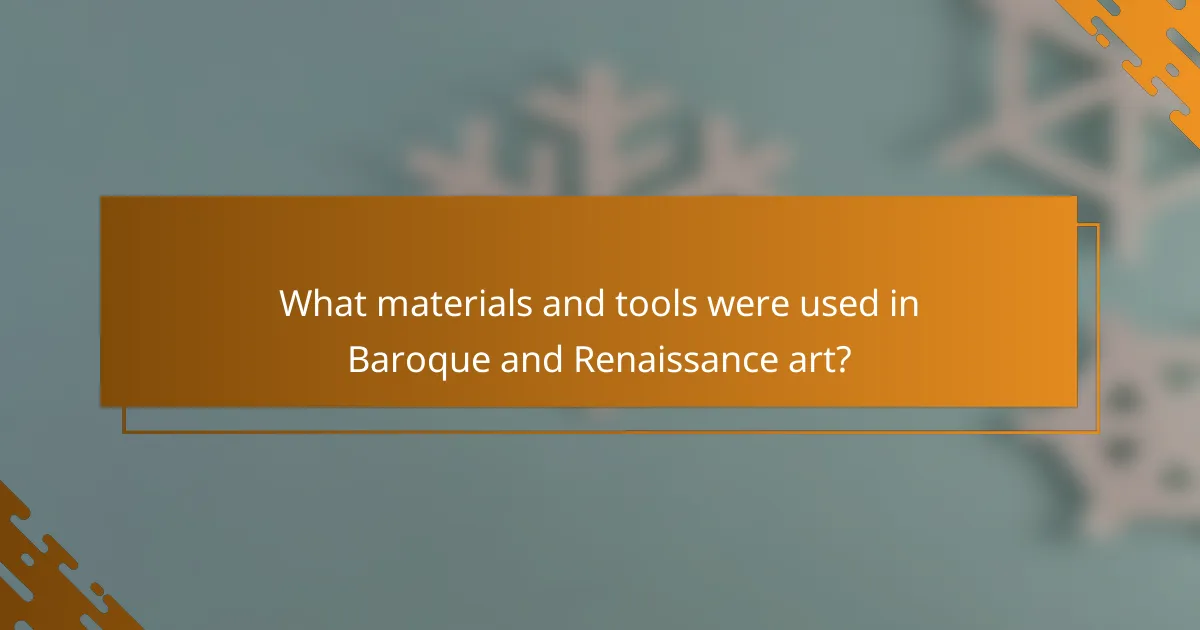
What materials and tools were used in Baroque and Renaissance art?
Baroque and Renaissance artists utilized distinct materials and tools that reflected their unique styles and techniques. Baroque art is characterized by the use of oil paints, while Renaissance artists often preferred fresco and tempera mediums.
Baroque artists used oil paints for depth
Baroque artists primarily employed oil paints, which allowed for greater depth and richness in color. This medium enabled them to create dramatic contrasts between light and shadow, enhancing the emotional impact of their works.
Oil paints dry slowly, giving artists the flexibility to blend colors and make adjustments over time. This quality was particularly advantageous for achieving the intricate details and textures that define Baroque masterpieces.
Renaissance artists favored fresco and tempera
Renaissance artists typically favored fresco and tempera as their primary mediums. Fresco involves applying water-based pigments onto freshly laid wet plaster, resulting in vibrant colors that become an integral part of the wall surface.
Tempera, made from pigments mixed with a water-soluble binder like egg yolk, was also popular for its quick-drying properties and fine detail capabilities. Both methods required meticulous planning and execution, reflecting the Renaissance emphasis on precision and harmony in art.
